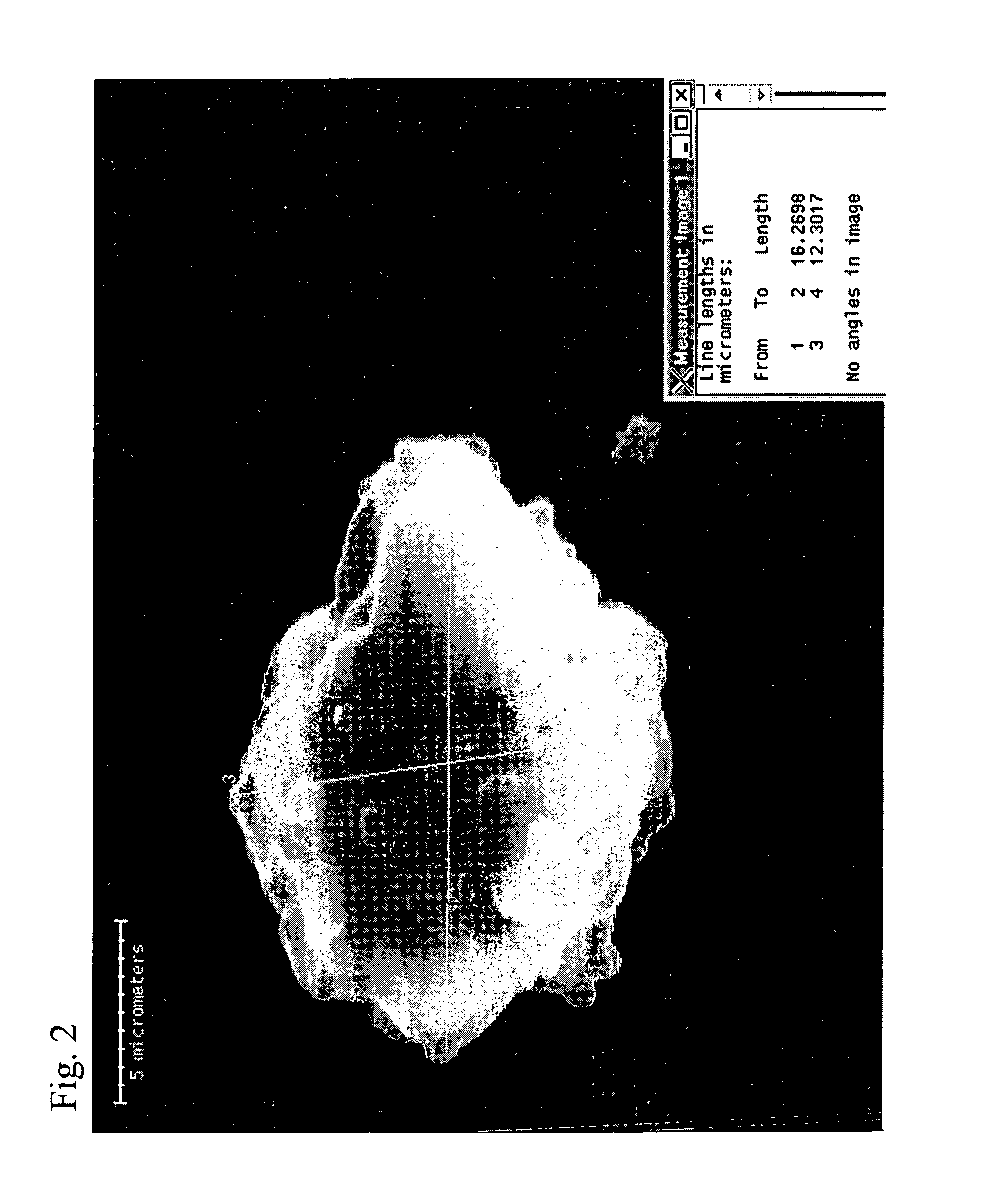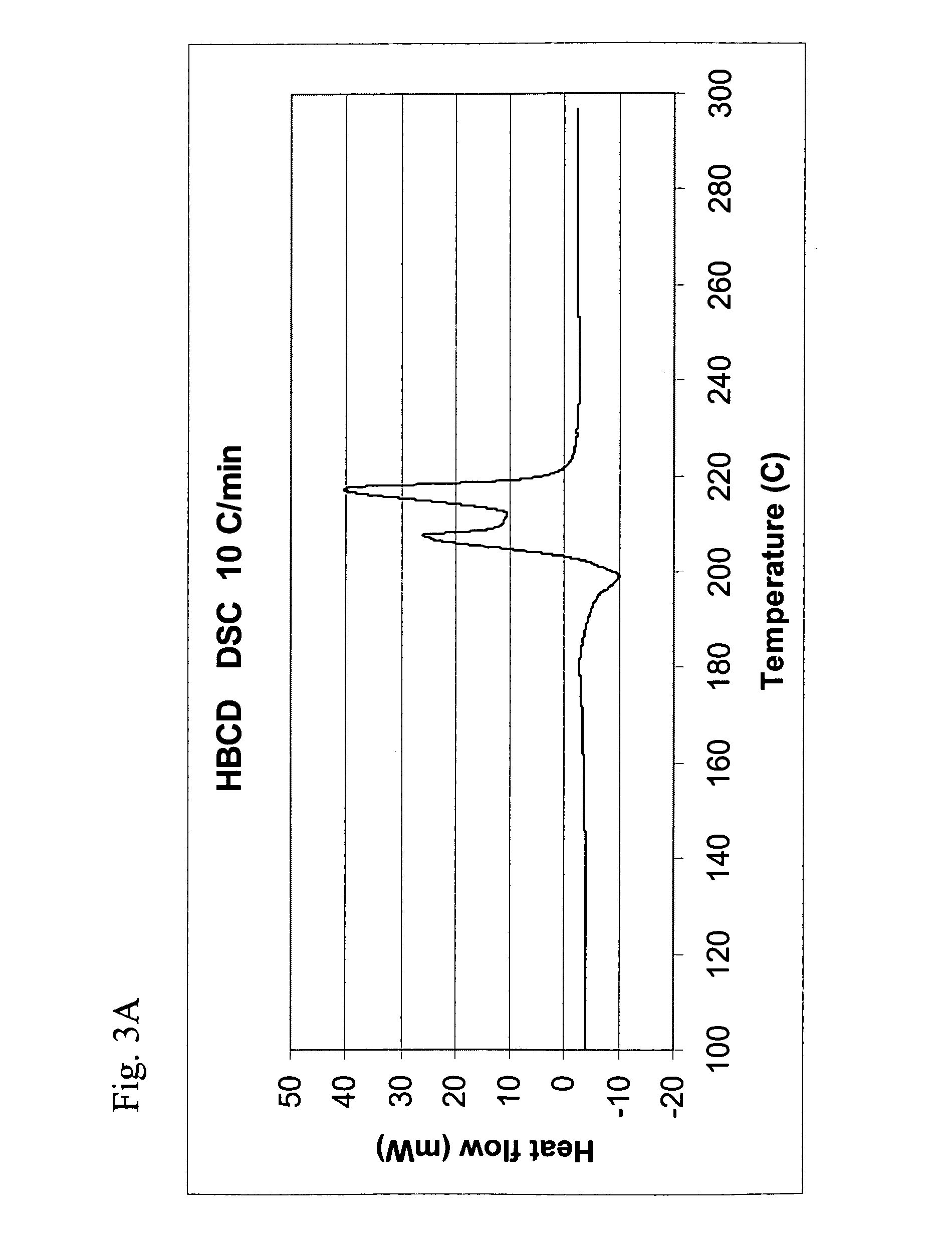Multi-functional microencapsulated additives for polymeric compositions
a polymeric composition and additive technology, applied in the field of polymeric foams, can solve the problems of difficult dispersibility of polymeric materials in polymeric compositions, bioaccumulation and ecotoxicity problems, and difficult processing of polymeric materials, etc., to achieve the effect of improving fire resistance, reducing thermal conductivity, and reducing the number of sinterings
- Summary
- Abstract
- Description
- Claims
- Application Information
AI Technical Summary
Benefits of technology
Problems solved by technology
Method used
Image
Examples
example 1
[0031]A polyurethane polymer was mixed with zinc borate (Zn3B4O9·5H2O) and the mixture was crosslinked in aqueous solution. HBCD, water, and dispersing agent were separately mixed to form a suspension, which was then added to the aqueous solution. The resulting microencapsulated HBCD was filtered and washed to yield a product constituted of approximately 90 weight percent HBCD and 10 weight percent polyurethane. The mean diameter of the particles was 5.0 microns, and approximately 75 weight percent of the particles had diameters≦5 microns.
[0032]The morphology of the microencapsulated HBCD particles, at scales of 10 μm and 20 μm, respectively, are shown in FIGS. 1 and 2. The results of differential scanning calorimetry (DSC) tests, reported in FIG. 3, demonstrate that HBCD microencapsulated in accordance with the present invention (FIG. 3B) remains stable at temperatures approximately 60° C. higher than achieved with conventional unencapsulated HBCD (FIG. 3A).
example 2
[0033]A polystyrene formulation was prepared by mixing 393 kg polystyrene, 2.4 kg talc, 1.8 kg pink colorant, and 3 kg of the microencapsulated HBCD product of Example 1. The formulation was mixed at 240° C. and 11 weight percent of a HCFC-142b blowing agent was added to the mixture under a pressure of 60 bar. The formulation was then extruded at 120° C. through a die, whereupon it expanded into a foam having an expansion ratio of approximately 60.
[0034]The resulting foam was 25 mm in thickness, with a cell size of approximately 0.31 mm×0.34 mm×0.30 mm. The foam had an oxygen index greater than 26% tested according to ASTM D2863, a fresh compressive strength of 180 kPa tested according to ASTM D1621, a fresh thermal conductivity at a 24° C. mean temperature of 0.0203 W / m·K tested according to ASTM C518, and a density of 35.1 kg / m3 tested according to ASTM D1622.
example 3
[0035]A polystyrene formulation was prepared by mixing 387 kg polystyrene, 2.4 kg talc, 0.4 kg pink colorant, and 10 kg of the microencapsulated HBCD product of Example 1. The formulation was mixed at 240° C. and 11 weight percent of a HCFC-142b blowing agent was added to the mixture under a pressure of 60 bar. The formulation was then extruded at 120° C. through a die, whereupon it expanded into a foam having and expansion ratio of approximately 60.
[0036]The resulting foam was 25 mm in thickness, with a cell size of approximately 0.29 mm×0.28 mm×0.27 mm. The foam had an oxygen index of 29% tested according to ASTM D2863, a fresh compressive strength of 184 kPa tested according to ASTM D1621, a fresh thermal conductivity at a 24° C. mean temperature of 0.0197 W / m·K tested according to ASTM C518, and a density of 35.3 kg / m3 tested according to ASTM D1622.
[0037]Two different views of the microstructure of this polystyrene foam are provided in FIGS. 4 and 5 illustrating the inclusion o...
PUM
| Property | Measurement | Unit |
|---|---|---|
| weight percent | aaaaa | aaaaa |
| median diameter | aaaaa | aaaaa |
| diameters | aaaaa | aaaaa |
Abstract
Description
Claims
Application Information
 Login to View More
Login to View More - R&D
- Intellectual Property
- Life Sciences
- Materials
- Tech Scout
- Unparalleled Data Quality
- Higher Quality Content
- 60% Fewer Hallucinations
Browse by: Latest US Patents, China's latest patents, Technical Efficacy Thesaurus, Application Domain, Technology Topic, Popular Technical Reports.
© 2025 PatSnap. All rights reserved.Legal|Privacy policy|Modern Slavery Act Transparency Statement|Sitemap|About US| Contact US: help@patsnap.com



